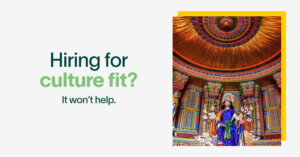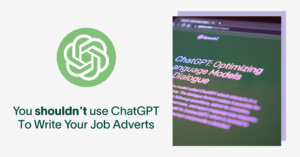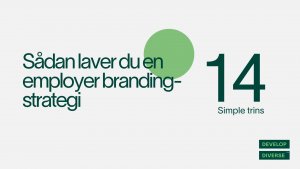If we think about it, the hiring process never really was built equally for everyone. Part of the problem is that it’s always relied on humans — and humans are notoriously biased.
We’re biased about what kind of names we expect to see on a CV, for example. We’re biased about the type of person we imagine in a role. We’re biased about physical appearance, someone’s university, or even the sports team that they like.
A lot of these biases operate at an unconscious level, so quickly that we’re barely even aware that they’re happening. But they can be immensely powerful in who gets the role, and can be a huge barrier to creating a more diverse and inclusive company.
In this post, Dr Ximena Hartsock, co-founder of BuildWithin, explains why organisations need to identify their unconscious biases in the recruitment process, and shares some strategies on how to overcome it.
How does unconscious bias show up in the recruitment process?
Unconscious bias is a judgement, belief or perception we have of an individual depending on characteristics that relate to their identity. In the recruitment process, unconscious bias can impact every phase of hiring, from who even sees and engages with your job advert to who ends up in the interview room and wins the role. It can show up in many different forms.
“Unconscious bias can impact the screening of resumes, leading to the exclusion of candidates based on factors such as the absence of a college degree or the presence of a foreign last name, which might indicate membership in a minority group,” explains Dr Ximena.
“[For example], gender bias emerges during the interview phase, where women are more likely to be questioned about their family and child-rearing responsibilities. Age bias tends to surface in technical and social media roles, where individuals over the age of 60 may face closer scrutiny compared to younger counterparts who are presumed to possess greater technological aptitude.”
But is unconscious bias always based on a negative judgement? No, says Dr Ximena — and that’s equally as important to recognise.
“We all have the potential to exhibit unconscious favouritism, and this bias can manifest during the interview process,” she explains. “For example, if a candidate happens to have attended my school or is a native of my city, there is a natural inclination to unconsciously favour that candidate.”
What are the risks of unconscious bias in recruitment?
When unconscious bias runs unchecked in your hiring process, it means that you’re not able to offer an inclusive, equitable experience for all of the candidates in your hiring pipeline. But crucially, this has a huge impact on the outcomes of your hiring process, too:
- Limited ability to hire top talent: When unconscious bias shows up in the recruitment process, it has a direct impact on an organisation’s likelihood of hiring the right person for the role. “Unconscious bias can lead to biased decision-making during the recruitment process,” explains Dr Ximena. “Biases based on factors such as gender, race, age, or appearance can result in organisations overlooking qualified candidates.”
- Lower performance and profitability: If you’re unable to attract and retain top-performing talent due to bias in your hiring process, it’s likely to have a knock-on impact on your organisation’s long-term performance. High-performing teams lead to higher revenue and profitability — but if you’re not able to identify that talent in the first place, then you’re at a competitive disadvantage.
- Non-inclusive workplace culture: When candidates experience unconscious bias in the recruitment process, it communicates that you’re not creating an environment that is inclusive and fair. Over the longer term, this will result in higher levels of attrition in marginalised employee populations.
- Reputational damage: In the age of social media, we’re far more likely to share when we’ve had a bad experience with an organisation. “Candidates who have a negative recruitment experience due to unconscious bias may share their experiences with others, both online and offline,” says Dr Ximena. “This negative word-of-mouth can harm the organisation’s reputation, leading to difficulties in attracting top talent and potential customers who value diversity and inclusion.”
6 practical strategies to identify and reduce unconscious bias
Organisations are made up of hundreds, sometimes thousands, of people. All of them are going to have their own unconscious biases that shape the way they think and make decisions. But when you’re trying to reduce the impact of unconscious bias in your organisation, your focus needs to be on changing processes and awareness, rather than people themselves.
1. Update your job descriptions.
Job descriptions can often be the first sign to a candidate that you have a biased idea of the ideal person for a role — especially if you have a laundry list of must-have requirements and experience.
“Eliminate rigid requirements like [university] degrees and focus on describing the skills needed for the role,” Dr Ximena advises. “Avoid vague language such as ‘attention to detail’ or ‘critical thinking’. Consider rethinking job titles to emphasise teamwork, such as using ‘team lead’ instead.”
2. Anonymise candidate CVs.
Name, location, and education bias can have a huge impact on how likely a candidate is to move from the application process to the next round of an interview. Removing any identifying details that communicate identifying details about a candidate’s identity, socioeconomic background, education level, age, or other factors that may introduce bias, will allow for a more objective evaluation of how qualified they are to perform a role.
3. Implement structured interview processes.
Humans are the most important part of the hiring process — but they’re also the least reliable. Thankfully, you can offset unconscious bias by developing more structure and standardisation around the interview process. Focus on equipping hiring managers and decision-makers as a first priority, and train them to lead more structured hiring processes that mean bias is a limited opportunity to creep in.
“Implement a structured interview process with standardised questions and evaluation criteria,” Dr Ximena suggests. “This helps ensure consistent and fair assessments of candidates and reduces the influence of personal biases. Develop interview guides that focus on relevant job-related competencies and skills.”
4. Implement diverse hiring panels.
The people tasked with making decisions about who gets hired at your organisation can have a huge impact on who gets in. And if everyone in your interview panels tends to come from the same socioeconomic, educational, or ethnicity background, then you could be unintentionally creating a biased process — however structured your interview.
“Multiple perspectives can help counteract individual biases and provide a more comprehensive evaluation of candidates,” says Dr Ximena. “Ensure that interviewers are trained on conducting unbiased interviews and evaluating candidates based on merit.”
5. Implement skills-based assessments.
Hiring assessments are often used by organisations to create a more ‘objective’ process. But in reality, they might not be as fair as we think. For one thing, they make a huge assumption that all candidates have the same experience, knowledge, and understanding to complete it. For another, they assume that everyone has the same amount of free time to do so — which can be difficult for candidates with parenting responsibilities, neurodivergent candidates, and those with disabilities.
Instead, Dr Ximena suggests using skills-based assessments: “Use non-technical assessments to assess candidates’ interests and skills,” she says. “These assessments can provide valuable insights into a candidate’s potential and suitability for the role, focusing on their abilities rather than relying solely on past experiences or qualifications.”
6. Survey your candidates after the hiring process.
Understanding how unconscious bias manifests in your hiring process is critical for making changes internally. But collecting data on your candidate experience can shed extra nuance on how your process makes candidates from different groups feel. Make it a practice to send an anonymous candidate experience survey at each phase of your hiring process that asks how well candidates feel represented, included, and welcomed during their experience. Be sure to provide opportunities for candidates to add extra commentary.
___
Global organisations including Maersk Tankers, Vestas, and Danske Bank all use Develop Diverse to help them identify and overcome unconscious bias in their recruitment process. Find out more by booking a demo.





